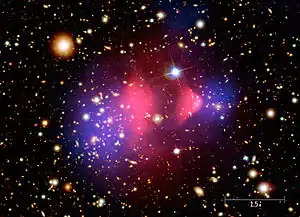Warm dark matter
Warm dark matter (WDM) is a hypothesized form of dark matter that has properties intermediate between those of hot dark matter and cold dark matter, causing structure formation to occur bottom-up from above their free-streaming scale, and top-down below their free streaming scale. The most common WDM candidates are sterile neutrinos and gravitinos. The WIMPs (weakly interacting massive particles), when produced non-thermally could be candidates for warm dark matter. In general, however the thermally produced WIMPs are cold dark matter candidates.
keVins and GeVins
One possible WDM candidate particle with a mass of a few keV comes from introducing two new, zero charge, zero lepton number fermions to the Standard Model of Particle Physics: "keV-mass inert fermions" (keVins) and "GeV-mass inert fermions" (GeVins). keVins are overproduced if they reach thermal equilibrium in the early universe, but in some scenarios the entropy production from the decays of unstable heavier particles can suppresses their abundance to the correct value. These particles are considered "inert" because they only have suppressed interactions with the Z boson. Sterile neutrinos with masses of a few keV are possible candidates for keVins. At temperatures below the electroweak scale their only interactions with standard model particles are weak interactions due to their mixing with ordinary neutrinos. Due to the smallness of the mixing angle they are not overproduced because they freeze out before reaching thermal equilibrium. Their properties are consistent with astrophysical bounds coming from structure formation and the Pauli principle if their mass is larger than 1-8 keV.
In February 2014, different analyses[1][2] have extracted from the spectrum of X-ray emissions observed by XMM-Newton, a monochromatic signal around 3.5 keV. This signal is coming from different galaxy clusters (like Perseus and Centaurus) and several scenarios of warm dark matter can justify such a line. We can cite, for example, a 3.5 keV candidate annihilating into 2 photons,[3] or a 7 keV dark matter particle decaying into a photon and a neutrino.[4]
In November 2019, analysis of the interaction of various galactic halo matter on densities and distribution of stellar streams, coming off the satellites of the Milky Way, they were able to constrain minimums of mass for density perturbations by warm dark matter Kevins in the GD-1 and Pal 5 streams. This lower limit on the mass of warm dark matter thermal relics mWDM > 4.6 keV; or adding dwarf satellite counts mWDM > 6.3 keV [5]
See also
- Dark matter – Hypothetical form of matter comprising most of the matter in the universe
- Hot dark matter (HDM) – A theoretical form of dark matter which consists of particles that travel with ultrarelativistic velocities
- Cold dark matter (CDM) – Hypothetical type of dark matter in physics
- Lambda-CDM model – Model of big-bang cosmology
- Modified Newtonian dynamics – Hypothesis proposing a modification of Newton's laws
References
- Bulbul, Esra; Markevitch, Maxim; Foster, Adam; Smith, Randall K.; Loewenstein, Michael; Randall, Scott W. (2014-06-10). "Detection of an Unidentified Emission Line in the Stacked X-Ray Spectrum of Galaxy Clusters". The Astrophysical Journal. 789 (1): 13. arXiv:1402.2301. Bibcode:2014ApJ...789...13B. doi:10.1088/0004-637x/789/1/13. ISSN 0004-637X.
- Boyarsky, A.; Ruchayskiy, O.; Iakubovskyi, D.; Franse, J. (2014-12-15). "Unidentified Line in X-Ray Spectra of the Andromeda Galaxy and Perseus Galaxy Cluster". Physical Review Letters. 113 (25): 251301. arXiv:1402.4119. Bibcode:2014PhRvL.113y1301B. doi:10.1103/physrevlett.113.251301. ISSN 0031-9007. PMID 25554871.
- Dudas, Emilian; Heurtier, Lucien; Mambrini, Yann (2014-08-04). "Generating x-ray lines from annihilating dark matter". Physical Review D. 90 (3): 035002. arXiv:1404.1927. Bibcode:2014PhRvD..90c5002D. doi:10.1103/physrevd.90.035002. ISSN 1550-7998.
- Ishida, Hiroyuki; Jeong, Kwang Sik; Takahashi, Fuminobu (2014). "7 keV sterile neutrino dark matter from split flavor mechanism". Physics Letters B. 732: 196–200. arXiv:1402.5837. Bibcode:2014PhLB..732..196I. doi:10.1016/j.physletb.2014.03.044. ISSN 0370-2693.
- Banik, Nilianjan; Bovy, Jo; Bertone, Gianfranco; Erkal, Denis; de Boer, T.J.L (6 November 2019). "Novel constraints on the particle nature of dark matter from stellar streams". arXiv:1911.02663 [astro-ph.GA].
- Viel, Matteo; Lesgourgues, Julien; Haehnelt, Martin G.; Matarrese, Sabino; Riotto, Antonio (2005-03-31). "Constraining warm dark matter candidates including sterile neutrinos and light gravitinos with WMAP and the Lyman-αforest". Physical Review D. 71 (6): 063434. arXiv:astro-ph/0501562. Bibcode:2005PhRvD..71f3534V. doi:10.1103/physrevd.71.063534. ISSN 1550-7998.
- King, Stephen F; Merle, Alexander (2012-08-16). "Warm Dark Matter from keVins". Journal of Cosmology and Astroparticle Physics. 2012 (8): 016. arXiv:1205.0551. Bibcode:2012JCAP...08..016K. doi:10.1088/1475-7516/2012/08/016. ISSN 1475-7516.
- Gao, L.; Theuns, T. (2007-09-14). "Lighting the Universe with Filaments". Science. 317 (5844): 1527–1530. arXiv:0709.2165. Bibcode:2007Sci...317.1527G. doi:10.1126/science.1146676. ISSN 0036-8075. PMID 17872439.
- Lin, W. B.; Huang, D. H.; Zhang, X.; Brandenberger, R. (2001-02-05). "Nonthermal Production of Weakly Interacting Massive Particles and the Subgalactic Structure of the Universe". Physical Review Letters. 86 (6): 954–957. arXiv:astro-ph/0009003. Bibcode:2001PhRvL..86..954L. doi:10.1103/physrevlett.86.954. ISSN 0031-9007. PMID 11177983.
- Millis, John. Warm Dark Matter. About.com. Retrieved 23 Jan., 2013. http://space.about.com/od/astronomydictionary/g/Warm-Dark-Matter.htm.
Further reading
- Bertone, Gianfranco (2010). Particle Dark Matter: Observations, Models and Searches. Cambridge University Press. p. 762. ISBN 978-0-521-76368-4.
